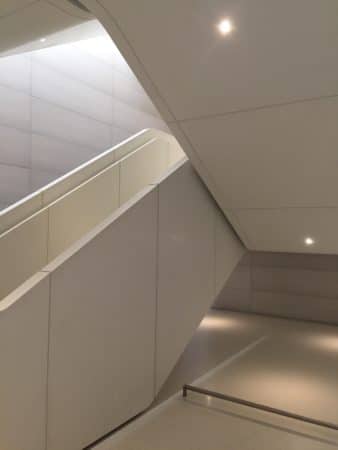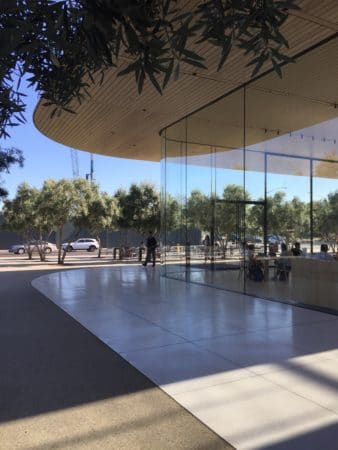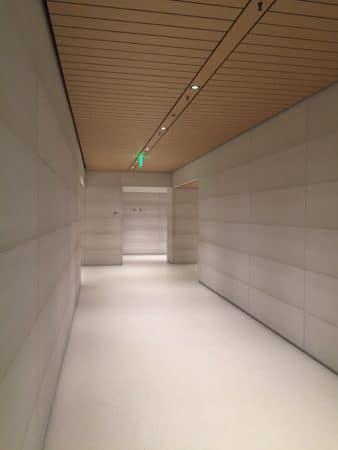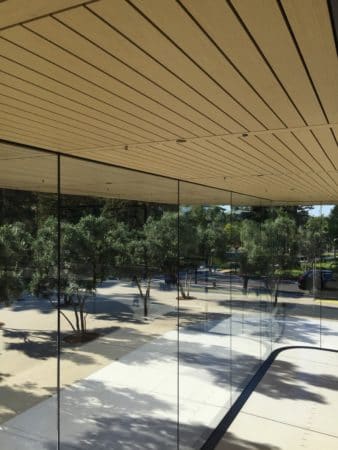Continued from page 2
Stairs and Basement Level
The stairs are quite beautiful and well-crafted, made of large stone panels and parts. It was not clear if this was the same stone as the walls, which I believe are the matching Serpeggiante Castagna limestone used at the Steve Jobs Theater. The whole stair floats off the side walls allowing light to penetrate deep into the stair all the way from the glazed stair penthouse at the roof level.

06 – From the bottom of the matching stairs that reach down to the basement level, one can see that the stone stairs feature integrated handrails carved into the stone inner wall.
Notice the little metal bar in the image above. I suppose it was meant to keep folks from walking under the rising section of the stair. The basement itself is where visitors can find restrooms and the basement, despite its limited public spaces, is serene and beautiful. One important note. There are no air registers for the AC and heating anywhere in this building. The space between the stone walls and the maple ceiling is a black recess zone which I suspect contains linear diffusers, or, perhaps the air flows through the black reveals of the maple boards themselves.
The stair (up) is just to my right in this image above. Spacious hallways lead visitors and staff to separate restroom facilities. The basement gets the same vertical-grain blonde (maple?) wood ceiling panels. A relentless quest for simplicity in the building is found everywhere in the visitors center, even in the restrooms themselves.
08 – From the stair landings half a flight down you can catch this view of the all-glass facade.
Coming down from the roof deck the stair landings u-turn twice and provide the visitor with this view over the guardrail. The glass walls are impressive as the roof appears to just simply float over the panes of glass and the space it helps to define.
It should be stated that at the Steve Jobs Theater the entire roof is only supported by the glass walls. And the electrical lines and water lines for the fire sprinkler system are fully located within narrow channels in the silicon joints between the glass. This does not have to be the case here, however. At the Steve Jobs Theater, a 155-foot diameter carbon fiber roof weighs 80 tons and bears entirely on the glass walls. If this is a similar structure—which I believe it is—than similar loads get transferred from core area columns and to the glass as well. You can see in image 09 below the extent of the roof cantilever over the glass walls, which must be load supporting.
Notes About the Glass
Architosh has noted before that Apple has broken records for the use of glass in buildings. This obsession with glass began many years ago with the first flagship Apple Stores. Steve Jobs and his team pushed their architects to the limit in thinking about innovative glass stairs, elevators—as in the famous cube store in New York City—floors and walls.
Most standard building glass is limited in size such that the smallest dimension can rarely exceed 60-inches in width, a standard size for heat-treating glass on high-speed furnaces at economies of scale. There are some glass fabricators that can exceed that, creating glass products at 60 – 84 inches and a few that can go even further, like Agnora in Canada which can produce glass for buildings at up to 130 inches in width and 300 inches in length. As a practicing architect, I’ve had the great pleasure to work with Agnora on a project with large glass dimensions. Working with over-sized glass has multiple complexities for just about any project. A surprising one is contractor-sided and deals with the sequencing of work as it relates to the equipment needed to lift into the place such large and heavy glass units.
Anyway, 130 x 300 inches is roughly 10 feet plus by 25 feet. That company makes the largest glass in North America for buildings and structures, but that is not who supplied glass at Apple Park.

09 – One final view of the Apple Park Visitor Center building. The ceiling and thus height of the glass is approximately 18 – 20 feet tall. Glass panels appeared to be approximately 8-9 feet wide.
Apple used a pair of German firms for its glass at Apple Park. Apple used a company named Sedak, which now can produce the world’s largest glass for buildings at sizes of up to 126 inches by 650 inches. While the width is slightly smaller than Agnora, in North America, Sedak can make glass twice as long. The glass facades at the Visitor Center are small enough to be produced by Agnora, but it seems more logical that Apple would source all the glass for the entire project from the same supplier despite more modest sizes. Sedak also can make such large pieces of glass in cold bent glass which was required not just at the round building at Apple Park but at rounded corners at the Visitor Center. (see image 09)
While Sedak produced the glass, engineering for the complex glass facades at Apple was reportedly done by another German firm Seele, a company that got its start as a glazier but today is one of the leading facade engineering firms in the world.
Note
This article was updated on 15 Aug 2018 with additional information.





Reader Comments
Comments for this story are closed